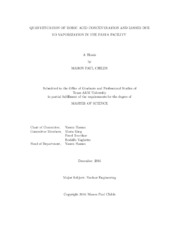| dc.description.abstract | During a loss of coolant accident in a pressurized water reactor, borated water is injected into the core through emergency core cooling system to reduce the decay heat, remove excess reactivity, and maintain an adequate core cooling throughout the full range of accident phases. Concentration of boric acid in the core is expected to increase over time due to the continuous vaporization of water from the core. Under certain conditions, the concentration may reach the solubility limit and precipitation of boric acid may occur. Hot leg switchover is a manual emergency procedure involving simultaneous injection through both the hot and cold legs to ensure adequate core flushing and prevent or mitigate precipitation of solid boric acid in the core.
The nuclear research community, industry, and regulatory commission are currently collaborating to understand the possible effects of the precipitation of boric acid on adequate core cooling during the long-term phase of a loss of coolant scenario, particularly in understanding whether modifications of the current procedures are required. An experimental apparatus was constructed to conduct experiments with de-ionized water and boric acid, to observe and study the ow behavior, and to measure the boric acid concentration in boiling water environments in geometry similar to a pressurized water reactor. Three methods for quantifying boric acid content at very high concentrations, even exceeding saturation, were explored. A gravimetric method for concentration determination proved to be the most effective for high values as were observed in the test facility. Concentration of solution in the test section was approximately solved using an analytic approach for comparison to experimentally determined values.
During experimentation, concentrations of boric acid were found to increase linearly with time. Rapid boiling in the test section induced uniform mixing in the test section, causing no appreciable difference in the concentration trends between various solution injection locations and other operational parameters of the facility. The rate of increase of boric acid concentration in the solution was observed to be proportional to the applied power to the heating rods in the facility test section. Comparison of boric acid concentration with the analytical solution confirmed that a fraction of the boric acid was transported within the vapor phase outside the test facility. Fractional boric acid loss from the test section was found to be lower than estimated from the observed losses during the calibration procedure.
The constructed facility is used in the study of effects of the precipitate on coolant flow conditions related to cooling capabilities during the long-term cooling phase in a loss of coolant accident. Acquiring this understanding could help the resolution of General Safety Issue 191 as imposed by the United States Nuclear Regulatory Commission. | en |


